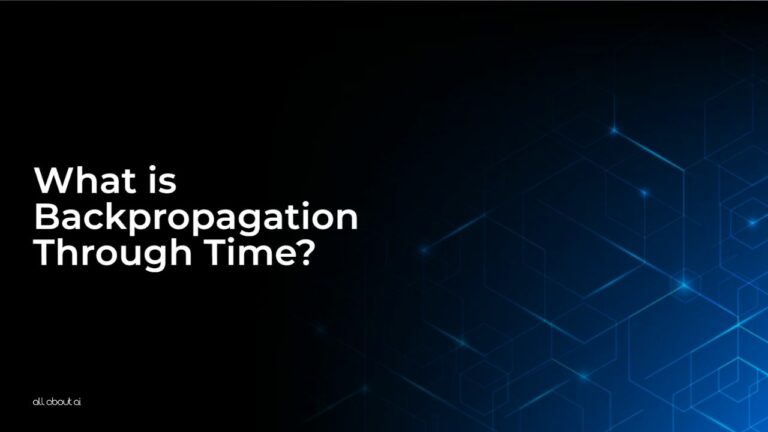Backpropagation through time is a variant of the standard backpropagation algorithm, tailored specifically for Recurrent Neural Networks (RNNs). It is designed to address the challenges of processing sequences of data where the input and output lengths can vary.
In standard feedforward neural networks, backpropagation works by calculating gradients to update the network’s weights. However, in RNNs, the network unfolds over time, creating a sequence of connected neurons. This temporal nature poses a unique challenge when it comes to training.
Backpropagation through time addresses this challenge by essentially “unrolling” the RNN over time. It transforms the sequential data into a fixed-length structure that can be processed by the standard backpropagation algorithm. This allows RNNs to learn from past time steps, making them capable of handling sequential data like time series, natural language, and more.
Learn more about Backpropagation Through Time by reading this article expertly curated by the AI maestros at All About AI.
Examples of Backpropagation Through Time
Time Series Prediction: In financial forecasting, BPTT can be applied to predict stock prices based on historical data. The network learns patterns and trends over time, improving its accuracy.
Natural Language Processing: BPTT is widely used in NLP tasks like language translation. It allows the model to consider previous words in a sentence when predicting the next one, enhancing translation quality.
Speech Recognition: When converting spoken language into text, BPTT helps RNNs capture phonetic nuances and context, improving the accuracy of speech recognition systems.
Video Analysis: BPTT can be used for action recognition in videos, enabling the model to understand temporal dependencies between frames.
Use Cases of Backpropagation Through Time
Predictive Text Input: BPTT revolutionizes smartphone keyboards by predicting the next word based on context, greatly enhancing typing efficiency. It improves typing speed, reduces errors, and offers personalized suggestions as it learns from users. Additionally, it facilitates seamless multilingual typing, making it a versatile tool for language input on mobile devices.
Financial Forecasting: In the world of finance, BPTT is indispensable for modeling and predicting market trends. It analyzes historical data to identify patterns and assess risks. Investment firms rely on BPTT for portfolio optimization and algorithmic trading strategies, maximizing returns while managing risk in complex and dynamic markets.
Healthcare: BPTT is instrumental in healthcare for disease prediction and treatment planning. It analyzes patients’ medical histories and vital signs over time, enabling early disease detection and personalized treatment regimens. Long-term monitoring and drug development benefit from BPTT’s ability to track health changes and assess treatment effectiveness.
Autonomous Vehicles: Self-driving cars leverage BPTT to process real-time sensor data, ensuring safe navigation. It fuses data from various sensors, plans optimal paths, and adapts to changing road conditions. BPTT also plays a crucial role in collision avoidance, making autonomous vehicles safer and more reliable on the road.
Pros and Cons
Pros
- BPTT excels at processing sequences, making it suitable for various applications.
- It enhances the accuracy of predictions in tasks involving time-dependent data.
- BPTT can be applied in diverse domains, from finance to healthcare.
Cons
- Training BPTT models can be computationally expensive.
- RNNs using BPTT may suffer from gradient-related issues, affecting training stability.
- Capturing long-term dependencies can be challenging for BPTT in very long sequences.
FAQs
What is backpropagation through time in RNN derivation?
Backpropagation through time (BPTT) in RNN derivation is a technique used to calculate gradients during the training of recurrent neural networks (RNNs). It unfolds the RNN over time to capture temporal dependencies, enabling the network to learn from past time steps and update its weights accordingly.
Why do we need backpropagation through time?
BPTT is essential for training RNNs on sequential data, such as time series or natural language, where past information influences future predictions. It addresses the challenge of processing sequences by allowing the network to propagate errors back in time and update its internal state.
What is the difference between backpropagation and backpropagation through time?
While standard backpropagation updates weights in feedforward neural networks, BPTT is tailored for RNNs, which have a temporal structure. BPTT unfolds the RNN over time, considering the sequence’s history, making it suitable for tasks involving time-dependent data.
How does backpropagation through time work?
BPTT works by unrolling the RNN over time, transforming sequential data into a fixed-length structure for gradient computation. It calculates gradients that flow backward in time, allowing RNNs to learn from past time steps, capture dependencies, and update their weights to improve sequential data processing.
Key Takeaways
- Backpropagation through time is a vital technique for training RNNs to handle sequential data effectively.
- It unrolls the network over time, allowing it to learn from past time steps.
- BPTT has wide-ranging applications, including time series prediction, NLP, and speech recognition.
- Pros include effective sequential data handling and improved accuracy, while cons involve computational intensity and gradient-related challenges.
Conclusion
The backpropagation through time technique empowers neural networks to handle sequential data, making it a cornerstone of various applications, from natural language processing to financial forecasting. By unrolling the network over time and allowing it to learn from the past, BPTT opens the door to improved accuracy and versatility.
To explore more AI concepts and expand your AI vocabulary, keep reading through our AI Knowledge Base.





